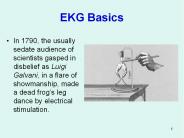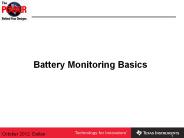Monitorthe basics - PowerPoint PPT Presentation
1 / 12
Title:
Monitorthe basics
Description:
... ray tube CRT, while portable computing devices such as laptops incorporate ... and are currently the primary technology for laptops and other mobile computers. ... – PowerPoint PPT presentation
Number of Views:145
Avg rating:3.0/5.0
Title: Monitorthe basics
1
Monitor-the basics
- Often referred to as a monitor, the display is
the most-used output device on a computer.. Most
monitors use a cathode ray tube CRT, while
portable computing devices such as laptops
incorporate liquid crystal display,
light-emitting diode, plasma or other image
projection technology. Because of their slimmer
design and smaller energy consumption, monitors
using LCD technologies are beginning to replace
the venerable CRT on many desktops.
2
(No Transcript)
3
Dot Pitch
- Briefly, the dot pitch is the measure of how much
space there is between a display's pixels. - Display on monitors normally can support
resolutions that match the pixel size as well as
several different resolutions. For example, a
display with a pixel grid of 1280 rows by 1024
columns can obviously support a maximum
resolution of 1280x1024 pixels. It usually also
supports lower resolutions such as 1024x768,
800x600, and 640x480.
4
(No Transcript)
5
Refresh Rate
- the refresh rate is the number of times that
the image on the screen is drawn each second. If
your monitor has a refresh rate of 72 Hertz (Hz),
then it cycles through all the pixels from top to
bottom 72 frames a second. Refresh rates are very
important because they control flicker results
from a variety of factors,. If the refresh rate
is too slow, the screen will appear to glimmer
6
Diagram of refresh rate i.e. (frames per
second) in computers as per computer settings,
used in conjunction with graphic card adapters
and programmable software.
7
Color Depth
- The combination of the display modes supported
by your graphics adapter and the color capability
of your monitor determine how many colors can be
displayed. The number of bits used to describe a
pixel is known as its bit depth. - Simply put, color bit depth refers to the
number of bits used to describe the color of a
single pixel. The bit depth determines the number
of colors that can be displayed at one time. Take
a look at the following chart to see the number
of colors different bit depths can produce
8
Colour depth in images
9
Flat Panel monitors
- CRT technology is still the most prevalent system
in monitors. Because standard CRT technology
requires a certain distance between the beam
projection device and the screen, monitors
employing this type of display technology tend to
be very bulky. Other technologies make it
possible to have much thinner displays, commonly
known as flat-panel displays.
10
Flat panel displays
11
(l c d)
- Liquid crystal display (LCD) technology works by
blocking light rather than creating it. LCDs
require far less energy than LED and plasma
technologies and are currently the primary
technology for laptops and other mobile
computers. As flat-panel displays continue to
grow in screen size and improve in resolution and
affordability, they will gradually replace
CRT-based displays.
12
Lcd screens on mobiles etc
- Lcd screens are also commonly used on mobile
phones and various other small utility devices.
organic light emitting diode is also used on most
modern mobile phones to produce outstanding
graphics and stunning visuals. O.l.E.D (organic
light emitting diode ) in the future might
replace lcd screens because it has better quality
images and uses less power.































